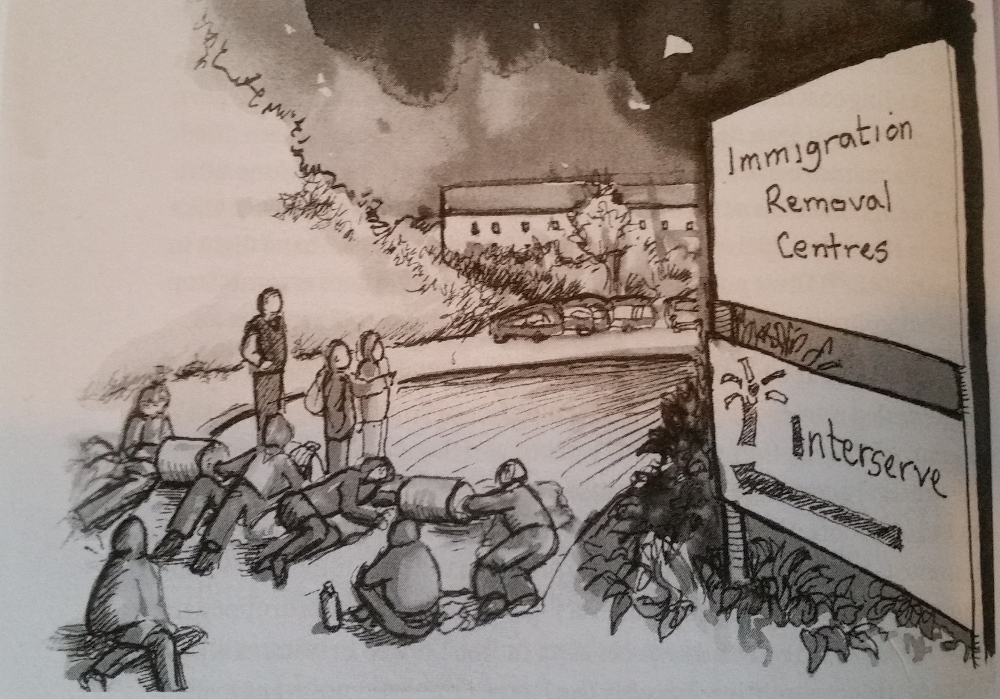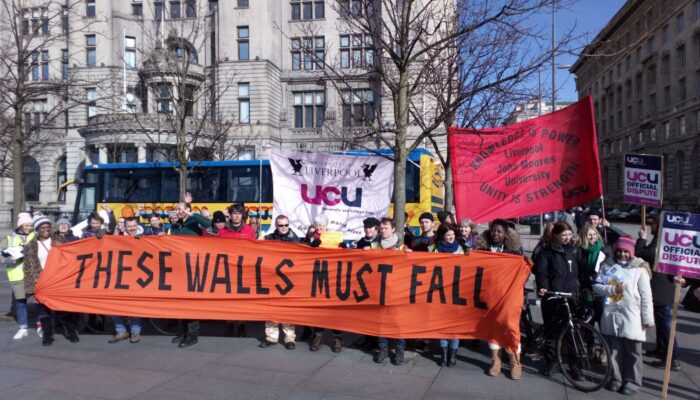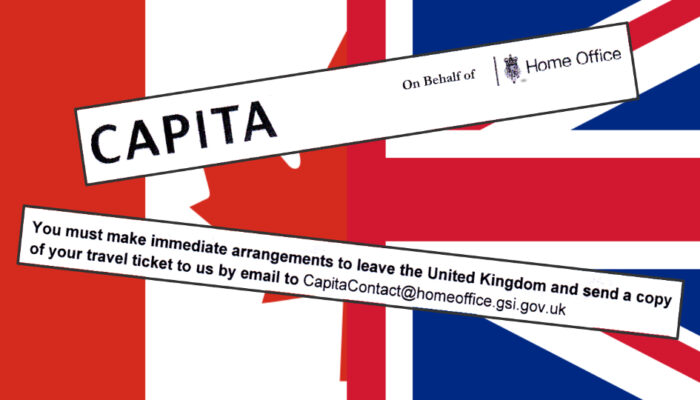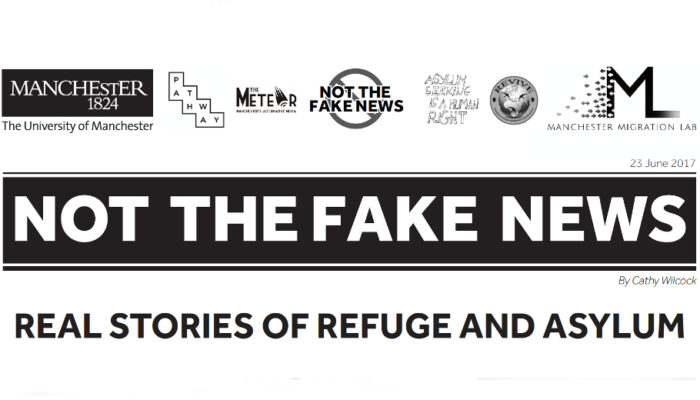Like many other UK citizens, I owe my existence in this country to family members who migrated here. My father and his family sailed here from India in 1948, escaping the horrors of partition, to settle in Farnworth. My maternal grandmother migrated from Ireland to Salford, seeking to escape the grinding poverty she grew up in. Arguably, if you go back far enough, we are all immigrants.
I have observed the developments of the Windrush scandal with growing unease and been left wondering: how did we get to a stage where the UK government is systematically abusing ethnic minority citizens of the UK? How far is the government prepared to go down this road of abusing and demonising immigrants, and what mechanisms are they using to achieve their aims? What driving forces are behind the implementation of the hostile environment?
The UK Border Regime: a critical guide, a book by investigative journalism co-operative Corporate Watch, provides some difficult answers to these and other questions regarding our treatment of immigrants. The extensive research presented in the book details the UK’s slide down the slippery slope of increasing xenophobia over a number of years. The ‘othering’ of immigrants, providing a distraction and scapegoat for many ills of society, is also presented as a major factor in this increasingly oppressive system. Alongside documenting the abuse and injustice intrinsic to our developing border regime, it also details the many instances of resistance to it. The knowledge of the system and examples of resistance in this book will empower those wishing to oppose the regime effectively.
How did we get to this stage?
An early recorded case of state sanctioned attacks on migrants in England, cited by the authors, occurred in the 13th century. Henry III attacked Jews by restricting their freedom to live in certain areas, work in certain trades, and more. The Crown went on to force Jews to wear yellow identification badges, then in 1290 the whole Jewish population was expelled from the country.
Jewish settlers are just one of many immigrant communities to suffer persecution in our infamous history of bad cross cultural relations. Considering the long history of migrant persecution by the state, It was surprising that systematic border controls in the UK didn’t begin until the 1905 Aliens Act. The Act separated those seeking to enter the country into citizens or aliens; the latter could be refused entry if they didn’t have sufficient funds, they were insane or a criminal, or if they had been refused previously.
Enoch Powell’s “rivers of blood” speech from 1969, which heightened racial tensions during a period of increased migration from the Caribbean and South Asia, gets its obligatory mention. Powell was sacked from the Conservative shadow cabinet the following day. The stirring up of hatred towards immigrants through the 60’s and 70’s resulted in the growth of racist organisations such as the National Front and the original British National Party. Margaret Thatcher mimicked the sentiments of Powell’s speech in 1978 when she said in an ITV interview that “people are rather afraid that this country might be swamped by people of a different culture”. The statement was made during a time of high opinion poll ratings over concerns on immigration, followed by a landslide Conservative victory in the 1979 general election. Yet during this time net migration was negative: there were more people leaving the country than entering it, and this negative net migration continued until 1983.
But Thatcher was more bark than bite when it came to imposing stricter immigration legislation; it was Tony Blair’s Labour government that really sank its teeth and its political capital into what the authors describe as a “war on asylum seekers”. From 1999 to 2009, successive Labour home secretaries introduced five new Immigration Acts, alongside the introduction of new detention centres (using PFI contracts) to cope with the deportation targets they set in 2000.
The Conservative/ Liberal Democrat coalition government then built on the groundwork provided by Labour and introduced a net migration target of no more than 100,000[CO1] – a target that has never been met. The key figure in the implementation of the ‘hostile environment’, Theresa May, became home secretary in 2012 and prime minister in 2016.
Net migration peaked in 2015 at over 300,000 migrants but the authors contend that subsequent reductions had little to do with immigration policy and more to do with the Brexit referendum which has scared off huge numbers of European immigrants. Net migration into the UK in 2017 was still 280,000, well above the 2010 target of 100,000.
Migration is primarily driven by wars, repressive governments, famine and poverty, and the authors point out that legislation is largely ineffective as a preventative.
A major strength of this book is the detail it provides on the development of a complex system of laws, collaborating organisations, bureaucracy and infrastructure that the government have put into place while travelling down this road of increased immigration control. The authors believe that this road is a dead end, which will never succeed “so long as the UK remains a democratic state with limits on the use of visible violence, and a capitalist economy that depends on migrant labour”.
Data driven hostile environment
Immigration raids carried out on behalf of the Home Office are described as the “basic terror tactic against migrants in the UK”. These raids, carried out by Immigration Compliance and Enforcement (ICE) teams, often alongside the police, are generally carried out as either dawn raids at residential addresses or during working hours at restaurants, shops and factories. There are around 6,000 raids a year, with arrests of around 5,000 people who are identified by ICE teams as ‘illegal’ immigrants.
The government’s ‘hostile environment’ also extends to the frosty working conditions of the ICE teams. ICE officers are described as being stressed, overworked, low-paid and subject to bullying, leading to “very, very low” morale.
Immigration Enforcement raids claim to be evidence-led, but the authors show that much of this evidence is very low grade from anonymous public sources, and they speculate (with some backing evidence), that many of the raids may be “fishing expeditions” with no prior intelligence.

The data in Home Office Immigration Enforcement databases and the Police National Database is supplemented by deals struck with the NHS, DVLA the Department of Education and others. Often the people working in these departments won’t realise that the information they put into a form could be used to detain and deport someone, and that they are unwittingly collaborating with the hostile environment agenda. The information gathering tendrils have been extended by legislation enforcing landlords and employers to determine immigration status for tenants/employees.
The Windrush scandal had many examples where people had lost their jobs and their homes. Although an attempt to get banks to check existing customers’ immigration status was suspended, the government has partnered with a private sector organisation, Cifas, representing banks and credit card companies. The Home Office has transferred personal data on over 200,000 immigration targets to this privately owned commercial database.
The authors believe that these and other examples demonstrate a concerted move towards a unified “Big Datasphere jointly run by the government and corporations” that holds everyone’s information. The evidence they provide suggests that Immigration Enforcement is one of the main areas where that drive is gaining ground. Soon the data gathering, storing and sharing systems applied to suspected ‘illegal’ immigrants could be applied to us all, although government ineptitude in IT projects may thankfully slow that process down.
Detention & deportation
Around 80,000 migrants such as asylum seekers currently have to endure the “limbo” of being “subject to reporting requirements” by the Home Office. They are considered as foreign nationals residing in the UK without permission and can be detained and deported if they don’t comply with reporting requirements or lose their appeal for asylum. A recent report in The Meteor showed how migrants subject to the reporting system in Stoke on Trent, were told that instead of reporting in Stoke they had to now report fortnightly at a centre in Salford (at least an 80 mile round trip) and had been provided with no information on provision for travel costs. Travel costs can account for a significant portion of the £36.95/week allowance asylum seekers are provided with, and taking paid work is prohibited while the asylum claim is ongoing.
Asylum seekers are entitled to housing, which is provided by the government via large outsourcing firms with regional contracts such as G4S, Clearsprings Group and Serco, which runs the contract for the North West of England. Slum conditions are widespread in the housing provided for migrants; the authors state:
“In Manchester Serco don’t treat bedbug outbreaks but simply wrap infested mattresses in plastic covers. These are not exceptional cases: water leaks, fire hazards, mould, rats, cockroaches and bedbugs appear standard.”
Migrants existing in and abiding by the UK immigration system can be detained at any time, usually while reporting at their assigned office, and be locked up without trial or time limit in immigration detention centres. They can be deported from there even if their asylum claim is still being processed; the government claim they can still follow up the claim from abroad, but in reality that proves mostly impossible
Someone detained in Manchester would likely be taken to the Residential Short Term Holding Facility called Penine House in Terminal 2 of Manchester Airport. This short term facility (up to seven days) is run by outsourcing giant Mitie, which the authors describe as “the UK’s biggest migrant detention profiteer” and also runs other detention centres at Heathrow, Colnbrook, Harmandsworth and Campsfield. Like many of the outsourcing giants it is having tough times financially, issuing a string of profit warnings and declaring losses in the last two years. Its work in immigration control has always remained profitable, with profits from government contracts predicted to be 20% or above. Investigations into Mitie’s recent financial reporting have been launched by the Financial Conduct Authority and the Financial Reporting Committee.
After seven days the detained person, could be transported to a long term detention facility such as Yarl’s Wood in Bedford. Detention should supposedly be a short term measure but as the UK is the only country in Europe with indefinite detention (France has a limit of 45 days) some detainees remain here for months and even years (in the worst case four years). Yarl’s Wood is currently run by Serco, another outsourcing giant in financial trouble. One way Serco and others have been allowed to cut their costs is to employ detainees in the facilities for as little as £1 hour. Theresa May says she wants to “defeat modern day slavery” occurring in the UK, yet condones its use in immigration detention centres across the country.

The authors describe detention as “a form of violent abuse” state the authors, which is not a statement I agree with, but there is no doubt that those detained are subject to violence and abuse due to the dangerous and stressful conditions they are subjected to by companies determined to protect their bottom line at the expense of those approximately 2,000 people currently detained; at an average cost of £86/day to the state. Recent scandals have concerned the sexual abuse of female detainees by Serco guards at Yarlswood, and the systemic humiliation and abuse of detainees at Brook House by G4S guards.
Of the 27,231 people detained in 2017 just under half, 13,173, were deported from detention; the rest are bailed or released without condition. Those deported are usually flown out, either handcuffed and guarded by private security guards or without escorts if they have accepted voluntary departure, which over 20,000 people did in 2017. Some leave on standard scheduled flights, as was intended for Jimmy Mubenga who was supposed to be deported on a British Airways flight in 2010 but instead was killed while being restrained by three G4S guards on the back seats of the plane. Others undergo mass deportations by chartered aircraft, taking place in secretive night flights concealed from public scrutiny; Corporate Watch describe these flights as “the system’s most brutal and terrifying instrument”. In some cases when these chartered flights have been delayed by activist action In many cases where these flights are delayed by activism, the extra time enables detainees to get legal challenges through and avoid deportation.
What are the driving forces?
A key pattern throughout the book is that any changes to public opinion and government policy are preceded by anti-immigrant propaganda from elements of the press and demonising rhetoric from politicians, leaving the impression that immigration policy in the UK is consistently driven more by hate and fear than facts.
Often politicians cite public opinion as being responsible for the tough immigration policies they introduce, though the authors cast doubt on the accuracy of how public opinion is measured. Although the number of people saying they want immigration being reduced repeatedly comes back at around 60% of those surveyed, the number saying they think immigrants have a positive or negative effect varies widely between surveys. It seems rational that immigration anxiety would correlate to the numbers of immigrants entering a country but Ipsos MORI, when looking at polls across Europe, found that there was no relationship between immigrant anxiety indicated in polls and the net migration levels for the country concerned.
The demographic data presented suggests that those who think immigration is a serious problem (10% of the population in 2000, rising to 20% in 2018) are likely to be older, white, working or middle class and primarily concerned about the perceived cultural implications of immigration rather than economic ones. These are people who are likely to be very vocal, to vote, to write to their MP and to buy newspapers.
The Media
The media’s role in stoking immigration anxiety gets its deserved attention, and although the authors say it is still subject to debate just how powerful the media is in affecting public opinion, they are in no doubt it plays a significant part in influencing opinion.
Polls show that news is primarily accessed through TV, radio, online or newspapers, and that the papers play a major role in setting what is reported in the other media. A study by UNHCR looking at countries in Europe showed the particular problem posed by the UK press:
“Coverage in the UK was the most negative and the most polarised… Britains right wing media was uniquely aggressive in its campaigns against refugees and migrants”.
Corporate Watch divides the traditional UK media into two camps. One is anti-migrant campaigning media, in which they place The Daily Mail, The Express, The Sun and The Telegraph, roughly in their order of vehemence. The four papers between them have around 60% of newspaper sales in the UK. Their commitment to their campaigns is demonstrated by The Express, which published 22 front page lead stories about asylum seekers and refugees in a 31 day period, including the not untypical “ASYLUM: Tidal wave of crime”.
The other camp is “Outlets which present a ‘debate’” into which the authors lump the rest of the UKs media. They contend that none are pro-migrant, although liberal migrant-friendly voices may be heard, and that they give an appearance “of ‘balancing’ different views”.
The media’s relatively constant anti-migrant agenda is boiled down to the lack of plurality in media ownership, and owners/editors imposing their own personal agendas onto the editorial line.
Describing the process of dissemination of anti-migrant stories and their endorsement and reinforcement of racist public attitudes as “propaganda spirals”, the authors go on to say:
“The media are not alone in repeating and reinforcing xeno-racism: politicians, teachers, academics, advertisers and all of us in our everyday communications can play a part. But the populist media’s endless repeated threat stories and hate speech makes a major contribution.”
The road ahead
Corporate Watch makes a brief mention of the geopolitical, economic and environmental forces that tend to drive migration. The book would have been more rounded with a more than superficial explanation of these issues, which I hope Corporate Watch will address in a future publication.
The final part of the book is dedicated to the question “How can we fight it”. For activists and those wishing to report on immigration issues there is a wealth of information on the nuts and bolts of the still developing immigration system. Many positive stories are included of immigrant revolts against the regime in detention centres, such as Campsfield in 1994 and 2004, Yarls Wood in 2002, and Harmandsworth in 2004 and 2006. Solidarity campaigners on the outside in 2015 also halted plans to expand the Campsfield site by a mixture of community organising, legal tactics, lobbying local politicians and carrying out media-based campaigning. Similar tactics by the Stop Detention Scotland campaign prevented the opening of a short-term detention facility at Glasgow airport in 2017. There is currently a number of campaign groups calling for a 28-day time limit instead of the indefinite detention immigrants are currently subject to.

My dad, Bob Bower, was no activist but he was a compassionate man and I am sure he would be appalled by the inhumane way immigrants are now treated under our still developing hostile environment. He sailed from India to the UK in 1948 on the SS Ranchi, with his parents and one of his brothers. He was on my grandparents’ passport so didn’t have his own, and didn’t get one till the late 1990’s. He acquired this in a straightforward manner, and was able to enjoy a little globe hopping, including a trip back to India, before he died in 2010. The UK’s implementation of a hostile environment makes me wonder: If he were still alive today would he get that passport so easily? Or would he have his human rights stripped away from him, his right to liberty, justice, paid work and a home denied?
Conrad Bower
Check out Corporate Watch – click here
Buy The UK Border Regime: a critical guide – click here
To find out more about immigration issues in Manchester contact RAPAR – click here
Featured image: Conrad Bower






Leave a Reply